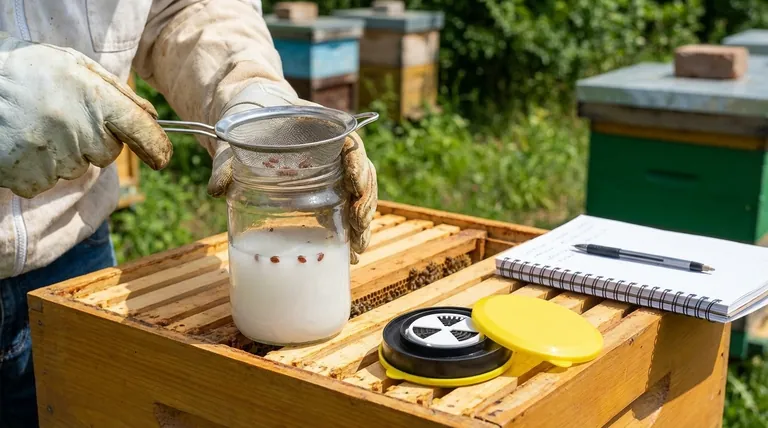The widely accepted treatment threshold for Varroa mites, based on a standard alcohol wash of 300 bees, is a 2 percent infestation rate. This translates to 6 mites found in your sample. While some experienced beekeepers may tolerate a rate up to 3 percent (9 mites), exceeding this level significantly increases the risk of colony failure.
Your alcohol wash result is not just a number; it's a critical indicator of future colony health. The 2-3% threshold is a proactive trigger point designed to force intervention before the mite population and the viruses they transmit reach a level from which the colony cannot recover.

Why a 2% Threshold is the Standard
Understanding the reasoning behind this number is crucial for effective hive management. It is based on the exponential growth of mites and their role as disease vectors.
Understanding Mite Population Dynamics
A 2% infestation may seem small, but the Varroa mite population grows exponentially. At any given time, the majority of female mites (up to 80%) are reproducing under the capped brood, hidden from your test.
The mites you count in an alcohol wash are only the "phoretic" mites riding on adult bees. A 2% reading indicates a much larger, unseen mite population is already developing within the brood cells. Waiting longer allows this hidden population to explode.
The Critical Role of Viruses
Varroa mites are the primary vector for numerous debilitating bee viruses, most notably the Deformed Wing Virus (DWV). Mites feeding on bee pupae activate and transmit these viruses.
A low mite level keeps the virus load in the colony manageable. As the mite population crosses the 2-3% threshold, the virus epidemic inside the hive accelerates dramatically, leading to sick, short-lived bees and eventual colony collapse. The goal of the threshold is to prevent this viral tipping point.
Understanding the Trade-offs
The 2% rule is a guideline, not an absolute law. Your specific situation may call for adjusting your tolerance, but you must understand the associated risks.
Reasons to Treat More Aggressively (Below 2%)
In some scenarios, treating at a lower threshold of 1% (3 mites) or even at the first sign of mites is the wisest course of action.
This is especially true in the late summer and early fall. The bees raised during this period are the "winter bees" that must survive for months. Protecting them from any mite-vectored virus damage is paramount for the colony's winter survival.
The Risk of a Higher Threshold (Approaching 3%)
Tolerating an infestation rate approaching 3% is a high-risk strategy. It is sometimes employed by beekeepers during a strong nectar flow to avoid contaminating honey with treatments.
However, this choice must be followed by immediate and effective treatment as soon as the honey supers are removed. Delaying treatment past the 3% mark, especially after mid-summer, often results in a colony that is too weak and virus-ridden to be saved.
The Danger of Inaction
Ignoring a mite count that exceeds 3% is the most common reason for overwintering colony losses. The colony may look strong in August or September, but the underlying virus epidemic is already taking hold.
By the time the symptoms of Parasitic Mite Syndrome (PMS)—such as scattered brood, crawling bees, and deformed wings—are visible, the mite population is extreme and the colony is almost certainly doomed.
Making the Right Decision for Your Apiary
Your treatment decision should be a calculated one based on the time of year and your management goals. Use your alcohol wash results as a non-negotiable data point to guide your action.
- If your primary focus is colony survival and honey production: Treat when your mite count reaches the 2% threshold (6 mites per 300 bees) to maintain a healthy, productive workforce.
- If you are preparing colonies for winter (late summer/early fall): Treat aggressively at a 1% threshold (3 mites), or even at the first mite detected, to ensure your winter bees are healthy and long-lived.
- If you are breeding for mite-resistant genetics: You might cautiously allow levels to approach 3% to identify survivor traits, but you must accept the significantly higher risk of colony loss this entails.
Consistent monitoring and taking decisive action based on these thresholds are the cornerstones of modern, sustainable beekeeping.
Summary Table:
| Key Metric | Threshold & Action | Risk Level |
|---|---|---|
| Standard Treatment Threshold | 2% (6 mites) | High Risk if exceeded |
| Late Summer / Fall Threshold | 1% (3 mites) | Critical for winter bee health |
| High-Risk Tolerance | 3% (9 mites) | Very High Risk of colony failure |
Protect Your Apiary's Health and Productivity
Consistent Varroa mite monitoring is essential for commercial success. HONESTBEE supplies the reliable beekeeping supplies and equipment that commercial apiaries and distributors need to implement effective Integrated Pest Management (IPM) strategies.
Ensure your colonies are protected with the right tools. Contact our expert team today to discuss wholesale supplies for your mite control program.
Visual Guide

Related Products
- Adjustable Formic and Acetic Acid Dispenser for Bee Mite Treatment
- 12V Bee Mite Removal Evaporator Oxalic Acid Vaporizer for Bee Fumigation Treatment 180W Atomization
- Professional Bamboo Queen Isolation Cage
- Varroa Easy Check Mite Tester Kit Counter Alcohol Wash Jar
- Professional Galvanized Hive Strap with Secure Locking Buckle for Beekeeping
People Also Ask
- What does Chewed Down Brood (CDB) indicate in bee colonies? A Sign of Varroa Mite Infestation
- What should be done after treating a colony for varroa mites? A Step-by-Step Guide to Verifying Success
- How do Varroa mites spread between honey bee colonies? Stop Mite Transmission in Your Apiary
- What is the focus of hive management during summer? Maximize Your Honey Harvest with Expert Tips
- What is the optimal time for varroa mite control in nucs? Maximize Efficacy with Perfect Timing



















